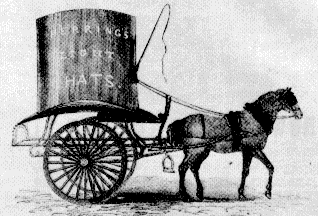Want to know how to navigate the Victorian Web? Click here.
[Adapted from George P. Landow, Victorian Types, Victorian Shadows: Biblical Typology in Victorian Literature, Art, and Thought (1980). Follow for full text.]
 After winning over his
Victorian audience, most of whose members were likely to be
deeply against Roman Catholicism, Carlyle pulls the rug out from under them
by locating an even more egregious symbolical grotesque in England. Taking "that
great Hat seven-feet high, which now perambulates London Streets" (10.141),
as such a grotesque emblem of EnglandÕs spiritual malaise, he demonstrates that
the underlying principle of modern business is, not to make better products,
but to convince one's potential customers by puffery that one has done so. Both
Carlyle's amphibious Pope and his seven-foot Hat
represent the sageÕs common technique of taking some trivial event as an emblem
of spiritual laws, and these contemporary examples often receive a heavy dose
of satire at his hands. Other exemplary facts, such as the population of England's
workhouses and the Irish widow
who only convinced the inhabitants of Edinburgh of her fellow humanity by giving
them typhus, are presented more somberly, though they also have satiric functions.
After winning over his
Victorian audience, most of whose members were likely to be
deeply against Roman Catholicism, Carlyle pulls the rug out from under them
by locating an even more egregious symbolical grotesque in England. Taking "that
great Hat seven-feet high, which now perambulates London Streets" (10.141),
as such a grotesque emblem of EnglandÕs spiritual malaise, he demonstrates that
the underlying principle of modern business is, not to make better products,
but to convince one's potential customers by puffery that one has done so. Both
Carlyle's amphibious Pope and his seven-foot Hat
represent the sageÕs common technique of taking some trivial event as an emblem
of spiritual laws, and these contemporary examples often receive a heavy dose
of satire at his hands. Other exemplary facts, such as the population of England's
workhouses and the Irish widow
who only convinced the inhabitants of Edinburgh of her fellow humanity by giving
them typhus, are presented more somberly, though they also have satiric functions.
The Sage's Techniques
- Invented Grotesques
- Reading the Fire Writing on the Wall
- Victorian Sages and the Homiletic Tradition
- Discovered Grotesques (1): The Amphibious Pope
- The Meaning of the World in the Meaning of a Word: Definitions from Carlyle to Suleri
Last modified 14 October 2002